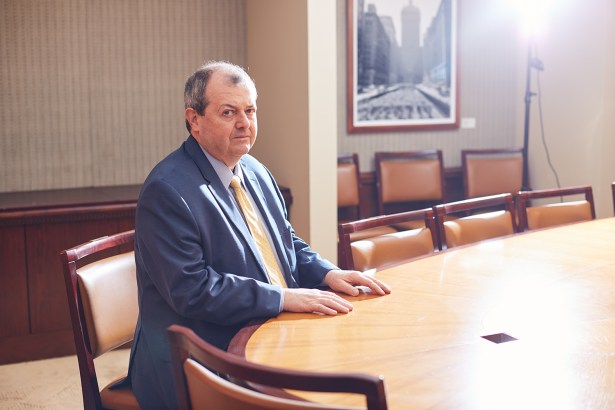James Whelan Talks Leading REBNY Through Turbulent Times
What it’s like to lead the Real Estate Board of New York when its members are feeling under siege.
By Nicholas Rizzi January 14, 2020 9:00 am
reprints
It’s a tough time to head up the Real Estate Board of New York. The 123-year-old trade organization suffered several public losses last year.
REBNY’s biggest blow came last June when the new class of progressive Democrats in Albany passed reforms to the state’s rent-stabilization system that the real estate industry unanimously opposed. While REBNY made its usual economic arguments to politicians, well-organized tenant and activist groups won out and got lawmakers on their side.
And there were other significant setbacks as well. In April 2019, the New York City Council passed a nine-bill package, the Climate Mobilization Act, which requires landlords to reduce their buildings’ carbon emissions — despite REBNY’s pushing for changes to the bill and their warnings that it would cost owners at least $4 billion citywide to make the renovations.
Then, the same month the rent reforms passed, REBNY president John Banks announced he would step down from his post after four years, remaining as a paid consultant to the board until this March. But REBNY didn’t have to look very far to find Banks’ replacement. The group tapped its executive vice president James Whelan, who’s been with REBNY since 2010.
“It’s been a challenging environment,” Whelan said. “John did a fantastic job in a difficult [period], having to deal with issues like 421-a [a tax break for development] and achieving things like the Garment Center rezoning. Having been here, it was an easier learning curve [for me] than others might have had to face.”
Despite that challenging environment, Whelan is confident the real estate industry will pull through.
“The real estate industry is a resilient industry,” he said. “We’ve been through a lot in my tenure.”
Whelan — the son of Irish immigrants who grew up in Elmhurst, Queens, and still lives in the borough’s Bellerose neighborhood with his wife — started his career as a lawyer and then joined what’s now called the Union Square Partnership in 1995.

He later joined the newly formed Downtown Brooklyn Council — now called the Downtown Brooklyn Partnership — and helped create the redevelopment plans for Downtown Brooklyn. In 2003, he left to join the Bloomberg administration and served as chief of staff for Daniel Doctoroff, the deputy mayor for economic development, from 2005 to 2007. While there, Whelan worked on lease term changes for the World Trade Center site, took the helm on the construction of the National 9/11 Memorial and Museum, and worked on the Hudson Yards plan and the city’s failed Olympic bid. After his time in government, he spent a few years at Muss Development before he decided to join REBNY.
To start turning REBNY’s fortunes around, Whelan last month announced a partnership with sometimes-enemy Gary LaBarbera, the president of the Building Construction Trades Council of Greater New York, calling for the groups to unite in pushing for pro-development policies.
Commercial Observer sat down with Whelan to talk about REBNY’s tactics going forward, the partnership with LaBarbera, and hosting his first REBNY gala.
Commercial Observer: You mentioned the difficult environment, and the topic on everyone’s mind is rent control. What are REBNY’s problems with the changes?
James Whelan: What’s critical about the decision that was made in June is the impact that it’s going to have on the city’s future. Seventy percent of the rent-regulated buildings in the city were built before 1947; a little over 50 percent of them are 10 stories or less. By our estimate, the changes that were made in June are going to have two types of impact over time.
The day after they made those rent changes, those buildings were worthless [thanks to a likely lack of future investment and stricter caps on raising rent]. As a result, their assessments are going to go down over time and they’re going to generate less in property tax revenue. By our estimate, within five years the city will be collecting a billion dollars less each year from rent-regulated buildings in property taxes. It’s unlikely the next mayor — whoever he or she is — is going to decide to collect a billion dollars less. So they’ll push that tax burden over to different parts of Class 2 property, like co-ops and condominiums. We have a property tax system that doesn’t work already and it’s only going to put more stress on that system.
The other problem with the changes they made is particular to MCIs [Major Capital Improvements] and the IAIs [Individual Apartment Improvements], and your ability to maintain rent at a level that matches the expenses that rent-regulated buildings incur. Within five years you’ll have well over 250,000 units of rent-regulated housing in New York City that are going to have difficulty meeting the basic daily needs in terms of carrying out their managerial and operational responsibilities from a financial point of view.
I say all this [because] the rent changes in June really did not do much to address the city’s affordable housing prices. We have an affordable housing crisis, but it’s important to acknowledge what that crisis is and what it’s not. The changes will result in a diminishment of housing quality of rent-regulated stock in New York City and it’s going to put further stress on the next mayor’s ability to fund government services. One needs to keep in mind that if you want to have a progressive city and create a set of services to help those individuals and families most in need, you need to have a prosperous city because you’ve got to be able to pay for those services somehow.
How has the bill getting passed made REBNY change their tactics for the future? What lessons has the organization learned from it?
How we’re looking to operate differently moving forward — and we started to put this in place over the last few months and undoubtedly the result in June with the rent changes were frustrating — we’re very focused on working with elected officials to bring to them the best data to make decisions going forward. A very clear discussion of policy options and policy choices that aren’t based on what’s best for the real estate industry, but really what’s best for the city’s future.
With that in mind, one can’t lose sight of the fact that real estate is unique compared to any other industry, with respect to its positioning vis-à-vis New York City. Our fates are inextricably linked. If the real estate industry does well, the city does well. If the city does well, the real industry does well.
For example, the real estate industry accounts for 52 percent of the taxes the city collects on an annual basis. It’s a level of taxation that is sufficient to pay for the city’s entire workforce. If you keep putting constraints on the real estate industry — so that you have less economic activity here, less investment here — then what’s going to result is it’s going to be harder and harder to raise the tax revenue you need to pay for basic government service.

This message that you’re trying to get across — why do you think it failed to connect with the new legislation in Albany last year?
Housing is a critical issue, not only in New York City but in cities throughout the country and worldwide. In fairness to elected officials, they’re under a lot of pressure from constituents in terms of the housing challenges they face. The final set of negotiations did not go the way we expected and we’re going to redouble our efforts moving forward in terms of seeking modifications to the changes that were made in June so that landlords, moving forward, have the ability to maintain their buildings’ quality at a level that we can all be proud of, while at the same time seeking to work with elected officials to address what the city’s true affordable housing needs are.
What are some of the things you think the city should do to alleviate the affordable housing crisis?
It’s not an easy problem to tackle. At the end of the day, it’s going to come down to money in different forms. You got to look at the idea of how do you get more money into the pockets of folks who are low or very low income so they can pay the rent and they have choices? Number two is there has to be a much greater level of housing production in New York City than we have seen recently. Mayor Bill de Blasio and Mayor Bloomberg have done a very good job at boosting housing production. If you look from between 2005 and 2016, the city added a half-million more people to the population but only built 125,000 housing units. It just speaks to a basic issue of supply and demand.
We need to be looking for ways to work with the government to produce units at a rent that can help folks who are low or very low income.
With everything going on, have you had to reassure members that REBNY is still fighting, and is still getting wins?
The membership has been terrific. When you have a membership of 17,000, I’m sure you could always point to a voice or two that might not be the most positive, but I have found in my experience dealing with the membership that they are optimistic about the real estate community’s resilience.
We are concerned about some of the decisions that have been made by different levels of government over the last year or two in terms of the impact it’s going to have on the city’s future. But me, the staff [and] the members remain committed to ensuring a brighter future for the city and we know that’s going to take a lot of hard work, particularly in this challenging political environment, but there’s a lot of determination.
With the new wave of progressive politicians, do you think that REBNY can connect with them or is it sort of a closed-door?
In fairness, we may not see eye-to-eye with an elected official on a particular issue but that doesn’t mean that carries across the board. I haven’t found, from my personal experience, elected officials who are unwilling to have a conversation.
REBNY recently announced that it’ll be working closer with Gary LaBarbera and Building Trades. How did that come together and what was the thinking behind it?
A few things. I think Gary and Building Trades share our view that there’s been a number of things that have taken place in New York City recently that threaten the city’s growth. And growth is critically important for a number of reasons.
Our interests are aligned on not only that issue, but sort of a whole range of issues. I think it was a realization on our part and the part of the Building Trades that the last few years have really been focused on the 10 percent of the issues that we might not see eye-to-eye on and [that] we’re missing out on the opportunity to work constructively on the 90 percent of the things that we do agree on, while recommitting to try to get on the same page and find ways to resolve the 10 percent of the issues that we don’t necessarily see eye-to-eye on.
Have you started working on pushing any specific issues together yet?
We’ve worked closely just in the last few weeks on legislation introduced in the City Council that would radically alter the manner in which the city granted after-hours variances to do work [which would limit any construction company to three permits a week to work before 7 a.m. and after 6 p.m. on weekdays and one at all times on weekends]. I’m not suggesting one shouldn’t look at the way after-hour variances are given out, it’s an important issue. There’s a lot of data available on that and folks ought to be looking at the data to get an understanding of what works, what doesn’t work, where there are problems and seek to address where there are problems. But the way the legislation went about it was a very broad and sweeping change without really getting into the details of who was getting after-hour variances, why, and where might there be problems forming that more modest steps could be taken to address the problems.
The second area we’ve been working together on is the issue of mechanical space. Within buildings, there are floors allocated to dealing with electrical needs, energy needs, the basic functioning of buildings. This is going to take on more and more importance as sustainability becomes a bigger and bigger issue everywhere, but particularly in New York City because there’s going to be more and more requirements put on buildings to deal with their energy needs. There are efforts underway, both at a city and state level, to limit the ability to create floors more than 12 feet from floor to ceiling or 20 feet from floor to ceiling.
If you talk to architects and engineers, the folks who are experts in this, they’ll tell you that you need flexibility of as much as 40 feet for these mechanical floors to accommodate 21st century needs. The Building Trades have been particularly effective advocates on this because they build this stuff, they know it well and they also demonstrate that it’s not some esoteric topic that’s being discussed. It’s a topic that touches upon the ability to create jobs and create growth.
Since taking over as president, what’s been the most challenging thing about it?
We touch a lot; there’s a lot of issues both at a city and state level that we’re involved with. The need to build relationships and build coalitions with other groups, and to build deeper and stronger relationships with elected officials, takes time and time is one of the few commodities in life that is limited.
The annual REBNY Gala is coming up on Jan. 16 in Manhattan, and it’s going to be your first time hosting it. Are you nervous about that?
No, I’m lucky to have people that get stuff done. That helps lighten the load. I mean the banquet is a great opportunity to get together with 2,000 of our closest friends to celebrate an industry that’s really critical to the well-being of the city and to highlight some of the folks who are extra special.
Are you worried about trying to keep everybody quiet? Did you get a “shush” down?
I have not been practicing my shushing. I actually think one of the great things about the REBNY banquet is the ability to network, and it’s kind of hard to network without talking.


